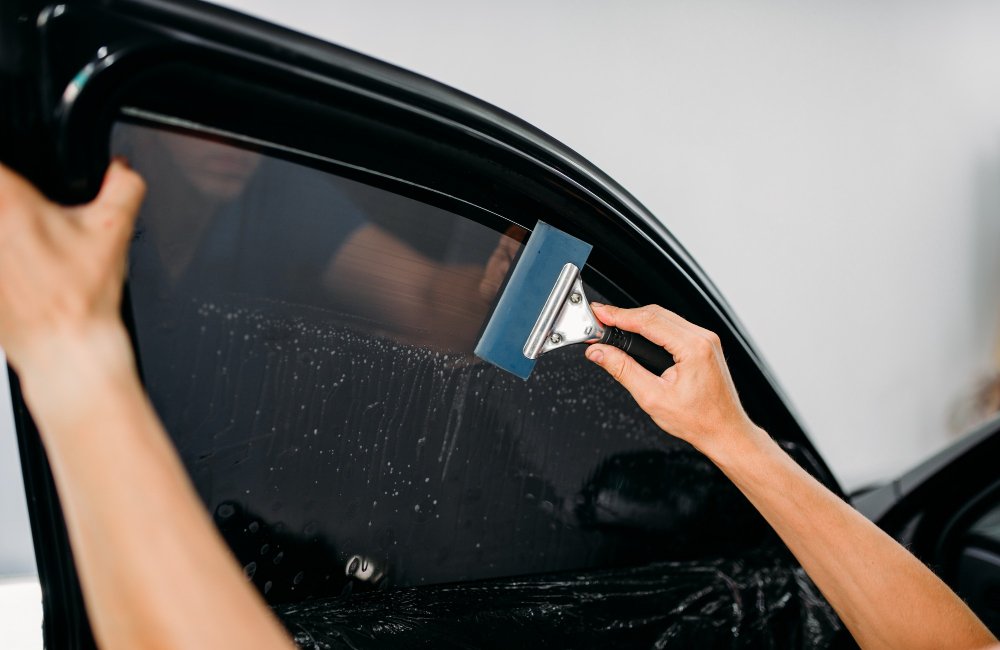
Table of Contents
Automotive window tint serves both style and practical purposes. Aside from providing enhanced window strength and durability, a high-quality car window tint offers excellent protection against harmful UV rays, safeguarding drivers and passengers. Modern premium window tints go the extra mile by reducing infrared exposure, effectively keeping your vehicle cooler during scorching summer days.
With the wide array of options available today, selecting the perfect window tint for your car, truck, SUV, or commercial vehicle can be overwhelming. The abundance of shades, varieties, and specialized tints can make the decision-making process confusing.
To simplify this task, our CeramicPro.com blog is here to help. We’ve compiled six useful tips to guide you in choosing the ideal car window tint that suits your specific vehicle, budget, and requirements. Let’s delve into these tips and make your window tint selection a breeze.
Tip #1 – Consider Your Location.
Before reaching out to a window tint installer in your area, the first factor to ponder is your location. Different regions have varying climate conditions and temperature levels, which directly impact the choice of window tint. Entry-level tints usually focus on enhancing aesthetics while providing basic protection against harmful UV rays like UVA and UVB, which can lead to skin cancer and interior damage.
If you reside in a hotter climate, such as the Southwest or Southeast US, or Latin America, opting for a car window tint that blocks Infrared Rays (IR protection) becomes crucial. This type of tint effectively blocks the sun’s heat, making it particularly beneficial for application on your windshield and front side windows.
On the other hand, for those living in colder climates, IR protection might not be a top priority, and UV blocking window film becomes more essential. Although IR film is an attractive upgrade, if interior cabin heat is not a significant concern for you, a good mid-grade window tint like a carbon color stable film should suffice to meet your needs.
Tip #2 – Are your car windows already equipped with privacy glass?
If you own a newer car, truck, or SUV, it’s possible that the rear windows (and sometimes the front ones) are already tinted. However, this tint is most likely factory-installed or what’s known as “privacy glass,” rather than a protective window film.
Privacy glass is a specific type of automotive window that includes a dark pigment added during the manufacturing process. Its primary purpose is to enhance privacy by limiting visibility into the car. While it may provide some glare reduction, it doesn’t offer significant benefits in terms of UV or IR blocking.
If you desire protection against harmful UV rays and heat-producing infrared (IR) radiation, and your car has privacy glass, you should consider installing a window tint that offers these protective qualities. Window tints can provide added UV and IR blocking benefits, helping to keep you and your passengers more comfortable and protected while driving.
Tip #3 – Learn the Lingo
After reviewing the information above, you may encounter some abbreviations that seem unclear. Let’s take a moment to clarify their meanings and introduce a few common terms often used to describe the advantages of window film.

VLT: Visible Light Transmission – This refers to the percentage of visible light that can pass through the window film. Higher VLT means more light can pass through, while lower VLT indicates darker tint.
VLR: Visible Light Reflectance – Refers to the percentage of visible light that is reflected by the window film. A higher VLR indicates that the film reflects more light, which can reduce heat and glare inside the vehicle.
TSER: Total Solar Energy Rejected – Refers to the percentage of total solar energy (comprising UV, visible light, and infrared radiation) that is rejected by the window film. A higher TSER indicates that the film is more effective at blocking solar heat from entering the vehicle, which helps to keep the interior cooler.
IR: Infrared Radiation – The heat-producing rays emitted by the sun that contribute to the warming effect inside a vehicle.
UV: Ultraviolet Rays – Harmful rays from the sun that can cause damage to the skin and interior materials.
Factory Tint: Pre-installed tint by the vehicle manufacturer on some windows, typically found on the rear and rear-side windows.
Privacy Glass: Windows with a dark pigment added during manufacturing to enhance privacy by limiting visibility into the vehicle.
Glare Reduction: The ability of window film to reduce the intensity of bright light, enhancing visibility and comfort for drivers.
Heat Rejection: The capacity of window film to block and reflect a portion of the sun’s heat, keeping the interior cooler.
So – as infrared rays pass through the window, they cause the temperature inside your vehicle to rise. An IR film’s primary purpose is to reject heat, allowing it to have a lighter tint percentage while still providing exceptional protection.
Although there are additional terms and jargon related to the quality of window tint, the ones mentioned above are the most essential to grasp.
Tip #4 – Know Your State's Window Tint Laws.
Window tint laws can vary significantly from one US State to another and across various Canadian Providences. These regulations primarily revolve around the Visible Light Transmission (VLT) or the level of darkness allowed for window tints. The main purpose of these laws is to ensure law enforcement officers’ safety during vehicle stops while also providing drivers with sufficient visibility to see other vehicles, especially in low-light conditions.
To determine the specific window tint laws in your state, you can use a designated link that provides relevant information. It’s essential to be aware of the tinting regulations in the state where your vehicle is registered, as compliance with these laws is crucial. If you plan to move to a different state in the near future, it’s advisable to familiarize yourself with the tinting laws of that state as well, to avoid any potential issues with law enforcement. Stay informed about the tinting requirements to drive safely and legally on the roads.
Tip #5 – Understand Your Options
After familiarizing yourself with the terminology and regulations in your area, it’s time to select the ideal window tint. Among the various options available, two types excel in providing top-notch protection and value for your investment, making them stand out as the best choices in the market.
Carbon Color Stable Window Tint
Premium window films with carbon technology deliver outstanding protective features, starting from the carbon window tint level. By infusing nano carbon particles into the tint, these films gain enhanced strength and resistance to shattering, while effectively blocking up to 99 percent of harmful UV rays, including UVA and UVB. This advanced shielding not only minimizes interior damage to seats, dashboards, and plastics, but also reduces the risk of skin cancer.
With proper installation, the latest carbon color stable window tints can offer more than a decade of reliable protection.
Ceramic IR Window Tint
The highest level of automotive window tint is the ceramic tint, offering the best combination of benefits. It provides exceptional protection by blocking almost all UVA and UVB rays, along with reducing over 90 percent of infrared transmission. Some advanced Ceramic IR tints can even elevate this protection to 96 percent. The tint is formulated with nanoceramic particles infused within multiple layers, resulting in a strong and durable adhesion that reflects sunlight instead of absorbing it.
While some of these advantages can be found in metalized, crystalline, or hybrid window films, they often come with the drawback of reduced cell phone signals. However, with the integration of nanotechnology in Ceramic IR window film, this issue is addressed. Your Bluetooth®, Wi-Fi, radio, and cell phone reception remain uninterrupted and unaffected.
Tip #5 – Understand Your Options
Finding the perfect automotive window film that suits your needs, preferences, and budget can be a challenging and time-consuming task for many vehicle owners. However, one of the best resources you can rely on is consulting a certified window tint installer in your area.
Unlike common misconceptions, tint installers and professional detailers are not pushy salespeople. They are committed to providing you with an exceptional experience, taking care of your vehicle, meticulously prepping the surfaces, and installing top-notch solutions that will stand the test of time.
At Ceramic Pro, we have assembled a team of window film installers dedicated to exceeding every customer’s expectations. They will guide you through the various benefits, limitations, and pricing options for Carbon Color Stable or Ceramic IR window tint. If one option better suits your requirements, they will provide you with an honest and accurate estimate, without any unnecessary hassle.
If you are seeking high-quality window tint for your car, at a price that fits your budget, click the button below to request a free estimate from a trusted window tint installer near your location.
